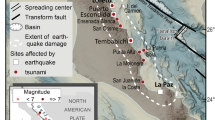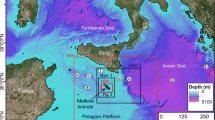Abstract
We present an analysis of the oldest detailed account of tsunami run-up in Indonesia, that of the 1674 Ambon tsunami (Rumphius in Waerachtigh Verhael van de Schuckelijcke Aerdbebinge, BATAVIA, Dutch East Indies, 1675). At 100 m this is the largest run-up height ever documented in Indonesia, and with over 2300 fatalities even in 1674, it ranks as one of Indonesia’s most deadly tsunami disasters. We consider the plausible sources of earthquakes near Ambon that could generate a large, destructive tsunami, including the Seram Megathrust, the South Seram Thrust, and faults local to Ambon. We conclude that the only explanation for the extreme run-up observed on the north coast of Amon is a tsunami generated by an earthquake-triggered coastal landslide. We use a two-layer tsunami model to show that a submarine landslide, with an approximate volume of 1 km3, offshore the area on Ambon’s northern coast, between Seith and Hila, where dramatic changes in coastal landscape were observed can explain the observed tsunami run-up along the coast. Thus, the 1674 Ambon tsunami adds weight to the evidence from recent tsunamis, including the 1992 Flores, 2018 Palu and Sunda Strait tsunamis, that landslides are an important source of tsunami hazard in Indonesia.








Similar content being viewed by others
Notes
A landslide located at Point B from ID-12—Table 4.
References
Audley-Charles, M., Carter, D., Barber, A., Norvick, M., & Tjokrosapoetro, S. (1979). Reinterpretation of the geology of Seram: Implications for the Banda Arcs and northern Australia. Journal of the Geological Society, 136(5), 547–566.
Baba, T., Allgeyer, S., Hossen, J., Cummins, P. R., Tsushima, H., Imai, K., et al. (2017). Accurate numerical simulation of the far-field tsunami caused by the 2011 Tohoku earthquake, including the effects of Boussinesq dispersion, seawater density stratification, elastic loading, and gravitational potential change. Ocean Modelling, 111, 46–54. https://doi.org/10.1016/j.ocemod.2017.01.002.
Baba, T., Gon, Y., Imai, K., Yamashita, K., Matsuno, T., Hayashi, M., & Ichihara, H. (2019). Modelling of a dispersive tsunami caused by a submarine landslide based on detailed bathymetry of the continental slope in Japan Nankai trough, southwest Japan. Tectonophysics, 768 (228182). https://doi.org/10.1016/j.tecto.2019.228182.
Baba, T., Takahashi, N., Kaneda, Y., Ando, K., Matsuoka, D., & Kato, T. (2015). Parallel implementation of dispersive tsunami wave modeling with a nesting algorithm for the 2011 Tohoku tsunami. Pure and Applied Geophysics, 172(12), 3455–3472. https://doi.org/10.1007/s00024-015-1049-2.
Brouwer, H. (1921). Some relations of earthquakes to geologic structure in the East Indian Archipelago. Bulletin of the Seismological Society of America, 11(3–4), 166–182.
Davies, H., Davies, J., Perembo, R., & Lus, W. (2003). The Aitape 1998 tsunami: Reconstructing the event from interviews and field mapping. In J. P. Bardet, F. Imamura, C. E. Synolakis, E. A. Okal, & H. L. Davies (Eds.), Landslide tsunamis: Recent findings and research directions (pp. 1895–1922). Basel: Springer. https://doi.org/10.1007/978-3-0348-7995-8_7.
Geller, R. J. (1976). Scaling relations for earthquake source parameters and magnitudes. Bulletin of the Seismological Society of America, 66(5), 1501–1523.
Giachetti, T., Paris, R., Kelfoun, K., & Ontowirjo, B. (2012). Tsunami hazard related to a flank collapse of Anak Krakatau volcano, Sunda Strait, Indonesia. Geological Society, London, Special Publications, 361(1), 79–90. https://doi.org/10.1144/SP361.7.
Hamilton, W. (1979). Tectonics of the Indonesian region (4th ed.). Washington: United States Government Printing Office.
Harris, R., & Major, J. (2017). Waves of destruction in the East Indies: The Wichmann catalogue of earthquakes and tsunami in the Indonesian region from 1538 to 1877. Geological Society, London, Special Publications, 441(1), 9–46. https://doi.org/10.1144/SP441.2.
Heidarzadeh, M., Krastel, S., & Yalciner, A. C. (2014). The state-of-the-art numerical tools for modeling landslide tsunamis: A short review. In S. Krastel, et al. (Eds.), Submarine mass movements and their consequences (pp. 483–495). Cham: Springer.
Honthaas, C., Réhault, J. P., Maury, R. C., Bellon, H., Hémond, C., Malod, J. A., et al. (1998). A neogene back-arc origin for the Banda Sea basins: Geochemical and geochronological constraints from the Banda ridges (East Indonesia). Tectonophysics, 298(4), 297–317. https://doi.org/10.1016/S0040-1951(98)00190-5.
Horspool, N., Pranantyo, I., Griffin, J., Latief, H., Natawidjaja, D., Kongko, W., et al. (2014). A probabilistic tsunami hazard assessment for Indonesia. Natural Hazards and Earth System Sciences, 14(11), 3105–3122. https://doi.org/10.5194/nhess-14-3105-2014.
Imamura, F., Synolakis, C. E., Gica, E., Titov, V., Listanco, E., & Lee, H. J. (1995). Field survey of the 1994 Mindoro Island, Philippines tsunami. Pure and Applied Geophysics, 144(3), 875–890. https://doi.org/10.1007/BF00874399.
Irsyam, M., Cummins, P., Asrurifak, M., Faisal, L., Natawidjaja, D., Widyantoro, S., et al. (2019). Development of the 2017 national seismic hazard maps of Indonesia. Earthquake Spectra. In press.
Irsyam, M., Sengara, I., Aldiamar, F., Widyantoro, S., Triyoso, W., Natawidjaja, D., Kertapati, E., Meilano, I., Suhardjono, Asrurifak, M., & Ridwan, M. (2010). Summary of study: Development of seismic hazard maps of Indonesia for revision of hazard map in SNI 03-1726-2002. Technical Report, Team for Revision of Seismic Hazard Maps of Indonesia, Bandung.
Jamelot, A., Gailler, A., Heinrich, P., Vallage, A., & Champenois, J. (2019). Tsunami simulations of the Sulawesi Mw 7.5 event: Comparison of seismic sources issued from a tsunami warning context versus post-event finite source. Pure and Applied Geophysics, 176(8), 3351–3376. https://doi.org/10.1007/s00024-019-02274-5.
Kanamori, H., & Anderson, D. L. (1975). Theoretical basis of some empirical relations in seismology. Bulletin of the Seismological Society of America, 65(5), 1073–1095.
Latief, H., Kodijat, A., Ismoyo, D., Bustamam, B., Adyasar, D., Nurbandika, N., & Rahayu, H. (2016). Air turun naik di tiga negeri. United Nations Educational, Scientific, and Cultural Organization, Office Jakarta - Indian Ocean Tsunami Information Centre, in Indonesian
Løvholt, F., Kühn, D., Bungum, H., Harbitz, C. B., & Glimsdal, S. (2012). Historical tsunamis and present tsunami hazard in eastern Indonesia and the southern Philippines. Journal of Geophysical Research: Solid Earth, 117(B9), B09310. https://doi.org/10.1029/2012JB009425.
McCaffrey, R. (1988). Active tectonics of the eastern Sunda and Banda arcs. Journal of Geophysical Research: Solid Earth, 93(B12), 15163–15182. https://doi.org/10.1029/JB093iB12p15163.
Okada, Y. (1985). Surface deformation due to shear and tensile faults in a half-space. Bulletin of the Seismological Society of America, 75(4), 1135–1154.
Okal, E. A., & Reymond, D. (2003). The mechanism of great Banda Sea earthquake of 1 February 1938: Applying the method of preliminary determination of focal mechanism to a historical event. Earth and Planetary Science Letters, 216(1–2), 1–15. https://doi.org/10.1016/S0012-821X(03)00475-8.
Okal, E. A., & Synolakis, C. E. (2004). Source discriminants for near-field tsunamis. Geophysical Journal International, 158(3), 899–912. https://doi.org/10.1111/j.1365-246X.2004.02347.x.
Pairault, A. A., Hall, R., & Elders, C. F. (2003). Structural styles and tectonic evolution of the Seram Trough, Indonesia. Marine and Petroleum Geology, 20(10), 1141–1160. https://doi.org/10.1016/j.marpetgeo.2003.10.001.
Patria, A., & Hall, R. (2017). The origin and significance of the seram trough, Indonesia.
Patton, J., Stein, R., & Sevilgen, V. (2018). Sunda Strait tsunami launched by sudden collapse of Krakatau volcano into the sea. Temblor. https://doi.org/10.32858/temblor.001.
Pownall, J., Hall, R., & Watkinson, I. (2013). Extreme extension across Seram and Ambon, eastern Indonesia: Evidence for Banda slab rollback. Solid Earth, 4(2), 277–314. https://doi.org/10.5194/se-4-277-2013.
Pownall, J., Hall, R., & Lister, G. (2016). Rolling open Earth’s deepest forearc basin. Geology, 44(11), 947–950. https://doi.org/10.1130/G38051.1.
Pranantyo, I. R., & Cummins, P. R. (2019). Multi-data-type source estimation for the 1992 flores earthquake and tsunami. Pure and Applied Geophysics, 176(7), 2696–2983. https://doi.org/10.1007/s00024-018-2078-4.
Rumphius, G. E. (1675). Waerachtigh Verhael van de Schuckelijcke Aerdbebinge. Dutch East Indies: BATAVIA.
Rumphius, G. E. (1997). True History of the terrible earthquake. (W. Buijze, translated by Beekman, E.M. and Foss, F. from (1675).
Sassa, S., & Takagawa, T. (2019). Liquefied gravity flow-induced tsunami: First evidence and comparison from the 2018 Indonesia Sulawesi earthquake and tsunami disasters. Landslides, 16(1), 195–200. https://doi.org/10.1007/s10346-018-1114-x.
Soloviev, S., & Go, C. N. (1974). Catalog of tsunamis in western coast of the Pacific Ocean (pp. 1–30). Moscow: Academy of Sciences, USSR, Izdat Nauka.
Soloviev, S., Go, C., & Kim, X. (1986). Catalog of tsunamis in the Pacific Ocean, 1969–1982 (p. 163). Moscow: MGC.
Spakman, W., & Hall, R. (2010). Surface deformation and slab-mantle interaction during Banda arc subduction rollback. Nature Geoscience, 3(8), 562. https://doi.org/10.1038/NGEO917.
Synolakis, C. E. (1991). Green’s law and the evolution of solitary waves. Physics of Fluids A: Fluid Dynamics, 3(3), 490–491. https://doi.org/10.1063/1.858107.
Synolakis, C. E., Bardet, J. P., Borrero, J. C., Davies, H. L., Okal, E. A., Silver, E. A., et al. (2002). The slump origin of the 1998 Papua New Guinea tsunami. Proceedings of the Royal Society of London Series A: Mathematical, Physical and Engineering Sciences, 458(2020), 763–789. https://doi.org/10.1098/rspa.2001.0915.
Watkinson, I. M., & Hall, R. (2017). Fault systems of the eastern Indonesian triple junction: Earth’svaluation of Quaternary activity and implications for seismic hazards. Geological Society, London, Special Publications, 441(1), 71–120. https://doi.org/10.1144/SP441.8.
Wells, D. L., & Coppersmith, K. J. (1994). New empirical relationships among magnitude, rupture length, rupture width, rupture area, and surface displacement. Bulletin of the Seismological Society of America, 84(4), 974–1002.
Wichmann, A. (1918). Die Erdbeben Des Indischen Archipels Bis Zum Jahre 1857. Amsterdam: Joahnnes Muller.
Wichmann, A. (1922). Die Erdbeben Des Indischen Archipels von 1858 bis 1877. Amsterdam: Uitgave van de Koninklijke Akademie van Wetenschappen.
Author information
Authors and Affiliations
Corresponding author
Additional information
Publisher's Note
Springer Nature remains neutral with regard to jurisdictional claims in published maps and institutional affiliations.
Rights and permissions
About this article
Cite this article
Pranantyo, I.R., Cummins, P.R. The 1674 Ambon Tsunami: Extreme Run-Up Caused by an Earthquake-Triggered Landslide. Pure Appl. Geophys. 177, 1639–1657 (2020). https://doi.org/10.1007/s00024-019-02390-2
Received:
Revised:
Accepted:
Published:
Issue Date:
DOI: https://doi.org/10.1007/s00024-019-02390-2




